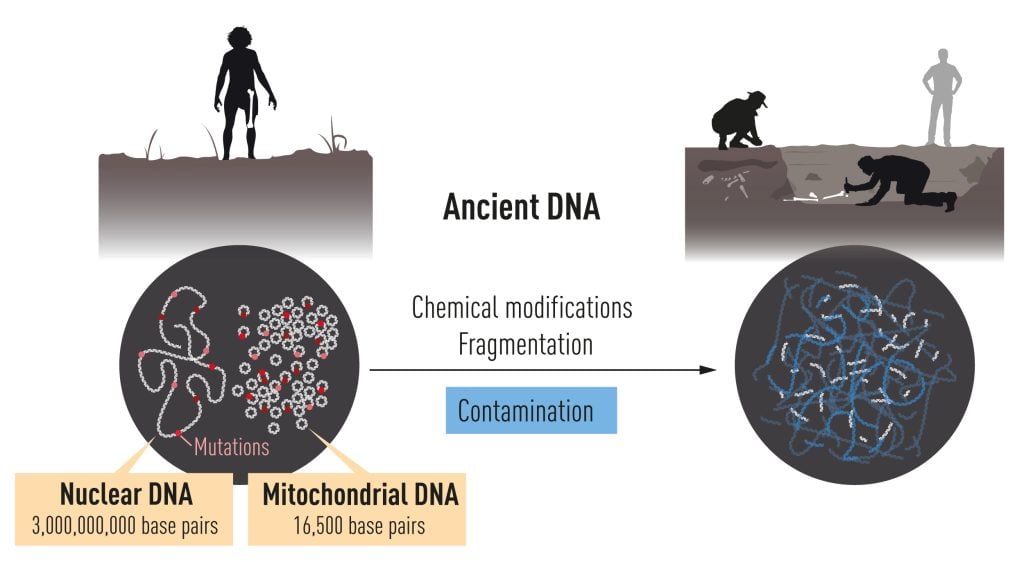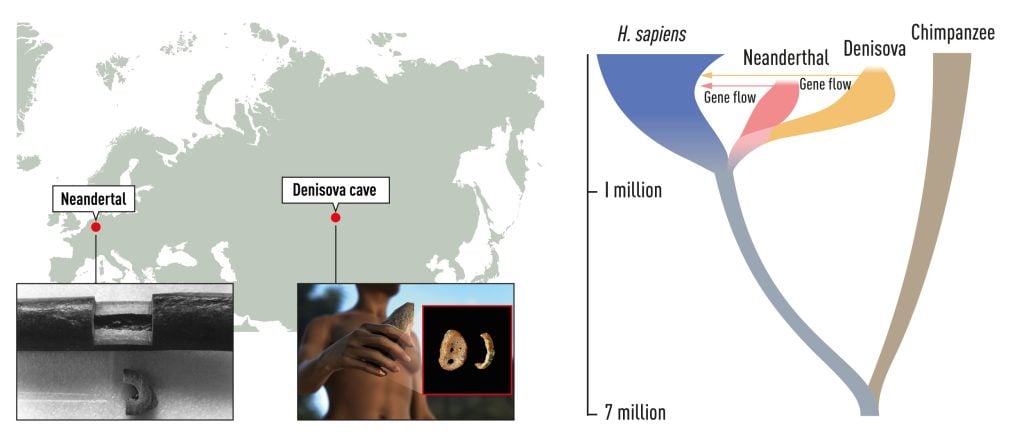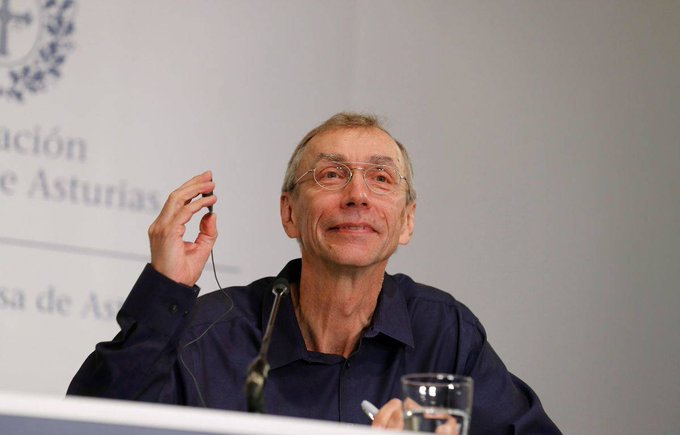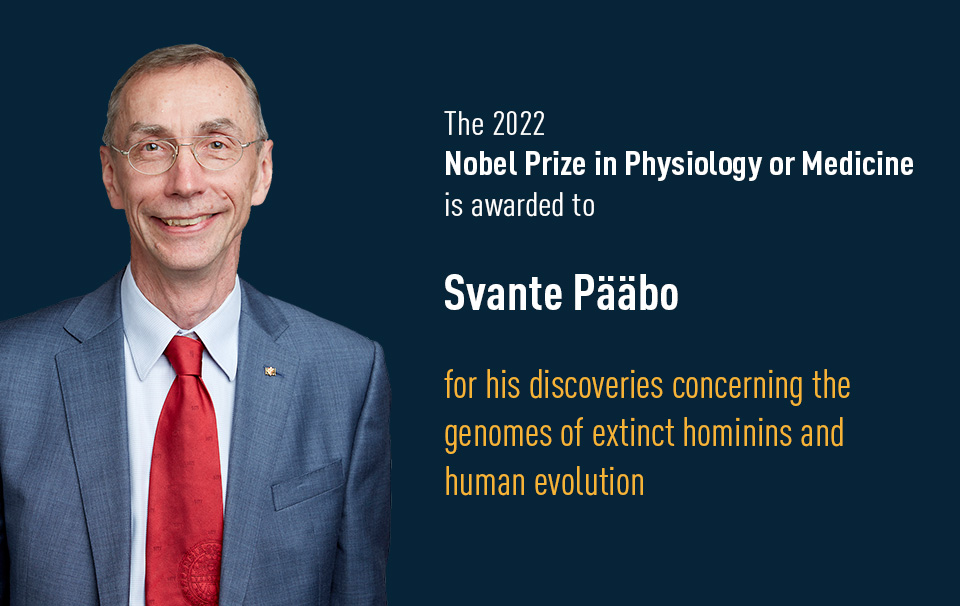Nobel Prize – ਸਵੀਡਨ ਦੇ ਸਵਾਂਤੇ ਪਾਬੋ ਨੂੰ ਫਿਜ਼ੀਓਲੋਜੀ ਜਾਂ ਮੈਡੀਸਨ ਵਿੱਚ ਨੋਬਲ ਪੁਰਸਕਾਰ ਦੇਣ ਦਾ ਐਲਾਨ
ਨਿਊਜ਼ ਪੰਜਾਬ
ਸਵੀਡਨ ਦੇ ਸਵਾਂਤੇ ਪਾਬੋ ਨੂੰ ਫਿਜ਼ੀਓਲੋਜੀ ਜਾਂ ਮੈਡੀਸਨ ਵਿੱਚ ਨੋਬਲ ਪੁਰਸਕਾਰ ਦਿੱਤਾ ਗਿਆ ਹੈ। ਉਨ੍ਹਾਂ ਨੂੰ ਇਹ ਪੁਰਸਕਾਰ ਵਿਲੁਪਤ ਹੋਮਿਨਿਨ ਅਤੇ ਮਨੁੱਖੀ ਵਿਕਾਸ ਦੇ ਜੈਨੇਟਿਕਸ (ਜੀਨੋਮ) ਨਾਲ ਸਬੰਧਤ ਖੋਜਾਂ ਲਈ ਦਿੱਤਾ ਗਿਆ ਹੈ। ਨੋਬਲ ਕਮੇਟੀ ਦੇ ਸਕੱਤਰ ਥਾਮਸ ਪਰਲਮੈਨ ਨੇ ਕੋਰੋਲਿਨਸਕਾ ਇੰਸਟੀਚਿਊਟ ਵਿੱਚ ਜੇਤੂ ਦਾ ਐਲਾਨ ਕੀਤਾ।ਨੋਬਲ ਕਮੇਟੀ ਨੇ ਇੱਕ ਬਿਆਨ ਵਿੱਚ ਕਿਹਾ, “ਕੋਰੋਲਿਨਸਕਾ ਇੰਸਟੀਚਿਊਟ ਦੀ ਨੋਬਲ ਕਮੇਟੀ ਨੇ ਅੱਜ ਅਲੋਪ ਹੋ ਰਹੇ ਹੋਮਿਨਿਨ ਅਤੇ ਮਨੁੱਖੀ ਵਿਕਾਸ ਦੇ ਜੀਨਾਂ ਨਾਲ ਸਬੰਧਤ ਖੋਜਾਂ ਲਈ ਸਵਾਂਤੇ ਪਾਬੋ ਨੂੰ ਫਿਜ਼ੀਓਲੋਜੀ ਜਾਂ ਮੈਡੀਸਨ ਵਿੱਚ 2022 ਦਾ ਨੋਬਲ ਪੁਰਸਕਾਰ ਦੇਣ ਦਾ ਫੈਸਲਾ ਕੀਤਾ ਹੈ।”
ਮੈਡੀਸਨ ਦੇ ਨੋਬਲ ਪੁਰਸਕਾਰ ਦੇ ਨਾਲ ਹੀ ਨੋਬਲ ਪੁਰਸਕਾਰਾਂ ਦਾ ਐਲਾਨ ਸ਼ੁਰੂ ਹੋ ਗਿਆ ਹੈ। ਹੁਣ ਭਲਕੇ ਯਾਨੀ ਮੰਗਲਵਾਰ ਨੂੰ ਭੌਤਿਕ ਵਿਗਿਆਨ, ਬੁੱਧਵਾਰ ਨੂੰ ਰਸਾਇਣ ਵਿਗਿਆਨ ਅਤੇ ਵੀਰਵਾਰ ਨੂੰ ਸਾਹਿਤ ਦੇ ਖੇਤਰ ਵਿੱਚ ਇਨ੍ਹਾਂ ਪੁਰਸਕਾਰਾਂ ਦਾ ਐਲਾਨ ਕੀਤਾ ਜਾਵੇਗਾ। 2022 ਦੇ ਨੋਬਲ ਸ਼ਾਂਤੀ ਪੁਰਸਕਾਰ ਦਾ ਐਲਾਨ ਸ਼ੁੱਕਰਵਾਰ ਨੂੰ ਕੀਤਾ ਜਾਵੇਗਾ ਅਤੇ ਅਰਥ ਸ਼ਾਸਤਰ ਪੁਰਸਕਾਰ ਦਾ ਐਲਾਨ 10 ਅਕਤੂਬਰ ਨੂੰ ਕੀਤਾ ਜਾਵੇਗਾ।
ਇਨਾਮਾਂ ਵਿੱਚ 10 ਮਿਲੀਅਨ ਸਵੀਡਿਸ਼ ਕ੍ਰੋਨਰ (ਲਗਭਗ $900,000) ਦਾ ਨਕਦ ਇਨਾਮ ਹੈ ਅਤੇ ਇਹ 10 ਦਸੰਬਰ ਨੂੰ ਦਿੱਤੇ ਜਾਣਗੇ। ਇਹ ਪੈਸਾ ਇਨਾਮ ਦੇ ਸਿਰਜਣਹਾਰ, ਸਵੀਡਿਸ਼ ਖੋਜੀ ਅਲਫ੍ਰੇਡ ਨੋਬਲ ਦੁਆਰਾ ਛੱਡੀ ਗਈ ਵਸੀਅਤ ਤੋਂ ਆਉਂਦਾ ਹੈ, ਜਿਸਦੀ ਮੌਤ 1895 ਵਿੱਚ ਹੋਈ ਸੀ।
ਜਿਸ ਖੋਜ ਲਈ ਪਾਈਬੋ ਨੂੰ ਸਨਮਾਨਿਤ ਕੀਤਾ ਗਿਆ ਹੈ, ਉਹ ਜਰਮਨੀ ਦੀ ਮਿਊਨਿਖ ਯੂਨੀਵਰਸਿਟੀ ਅਤੇ ਲੀਪਜ਼ੀਗ ਦੇ ਮੈਕਸ ਪਲੈਂਕ ਇੰਸਟੀਚਿਊਟ ਵਿੱਚ ਕੀਤੀ ਗਈ ਸੀ। ਪਾਬੋ ਦੀ ਖੋਜ ਦੱਸਦੀ ਹੈ ਕਿ ਕਿਵੇਂ ਪ੍ਰਾਚੀਨ ਮਨੁੱਖਾਂ ਦੇ ਜੀਨੋਮ ਬਦਲੇ ਅਤੇ ਮੌਜੂਦਾ ਮਨੁੱਖਜਾਤੀ ਆਪਣੇ ਪੂਰਵਜਾਂ ਤੋਂ ਕਿੰਨੀ ਵੱਖਰੀ ਹੈ। ਉਸਦੇ ਅਧਿਐਨਾਂ ਵਿੱਚ ਡੇਨੀਸੋਵਾ ਨਾਮ ਦੀ ਇੱਕ ਪ੍ਰਜਾਤੀ ਵੀ ਲੱਭੀ। ਪਾਬੋ ਦੀ ਖੋਜ ਸੁਝਾਅ ਦਿੰਦੀ ਹੈ ਕਿ ਆਧੁਨਿਕ ਮਨੁੱਖਾਂ ਕੋਲ ਅਜੇ ਵੀ ਪੂਰਵਜ ਨਿਏਂਡਰਥਲ ਅਤੇ ਡੇਨੀਸੋਵਨ ਦੇ ਜੈਨੇਟਿਕ ਗੁਣ ਹਨ।
ਆਪਣੀ ਪ੍ਰਾਪਤੀ ਬਾਰੇ ਜਾਣਕਾਰੀ ਦਿੰਦਿਆਂ ਨੋਬਲ ਪੁਰਸਕਾਰ ਕਮੇਟੀ ਨੇ ਕਿਹਾ ਕਿ ਪਾਬੋ ਦੁਆਰਾ ਪ੍ਰਗਟ ਕੀਤੇ ਜੈਨੇਟਿਕਸ ਵਿੱਚ ਅੰਤਰ ਉਹ ਹੈ ਜੋ ਜੀਵਤ ਮਨੁੱਖਾਂ ਨੂੰ ਅਲੋਪ ਹੋ ਚੁੱਕੇ ਪੂਰਵਜਾਂ ਤੋਂ ਵੱਖ ਕਰਦਾ ਹੈ। ਇਹ ਇਹ ਖੋਜ ਹੈ ਜੋ ਸਾਨੂੰ ਇਹ ਖੋਜਣ ਵੱਲ ਲੈ ਜਾਂਦੀ ਹੈ ਕਿ ਮਨੁੱਖੀ ਸਪੀਸੀਜ਼ ਵਿਲੱਖਣ ਕਿਉਂ ਹੈ।
ਹੋਰ ਖਬਰਾਂ ਪੜ੍ਹਣ ਲਈ ਇਸ ਲਿੰਕ ਤੇ ਜਾਓ 🙏🏻 https://newspunjab.net/
Swedish paleogeneticist Svante Paabo, who sequenced the genome of the Neanderthal and discovered the previously unknown hominin Denisova, on Monday won the Nobel Medicine Prize.”By revealing genetic differences that distinguish all living humans from extinct hominins, his discoveries provide the basis for exploring what makes us uniquely human”, the Nobel committee said.
Press release
2022-10-03
The Nobel Assembly at Karolinska Institutet
has today decided to award
the 2022 Nobel Prize in Physiology or Medicine
to
Svante Pääbo
for his discoveries concerning the genomes of extinct hominins and human evolution
Humanity has always been intrigued by its origins. Where do we come from, and how are we related to those who came before us? What makes us, Homo sapiens, different from other hominins?
Through his pioneering research, Svante Pääbo accomplished something seemingly impossible: sequencing the genome of the Neanderthal, an extinct relative of present-day humans. He also made the sensational discovery of a previously unknown hominin, Denisova. Importantly, Pääbo also found that gene transfer had occurred from these now extinct hominins to Homo sapiens following the migration out of Africa around 70,000 years ago. This ancient flow of genes to present-day humans has physiological relevance today, for example affecting how our immune system reacts to infections.
Pääbo’s seminal research gave rise to an entirely new scientific discipline; paleogenomics. By revealing genetic differences that distinguish all living humans from extinct hominins, his discoveries provide the basis for exploring what makes us uniquely human.
Where do we come from?
The question of our origin and what makes us unique has engaged humanity since ancient times. Paleontology and archeology are important for studies of human evolution. Research provided evidence that the anatomically modern human, Homo sapiens, first appeared in Africa approximately 300,000 years ago, while our closest known relatives, Neanderthals, developed outside Africa and populated Europe and Western Asia from around 400,000 years until 30,000 years ago, at which point they went extinct. About 70,000 years ago, groups of Homo sapiens migrated from Africa to the Middle East and, from there they spread to the rest of the world. Homo sapiens and Neanderthals thus coexisted in large parts of Eurasia for tens of thousands of years. But what do we know about our relationship with the extinct Neanderthals? Clues might be derived from genomic information. By the end of the 1990’s, almost the entire human genome had been sequenced. This was a considerable accomplishment, which allowed subsequent studies of the genetic relationship between different human populations. However, studies of the relationship between present-day humans and the extinct Neanderthals would require the sequencing of genomic DNA recovered from archaic specimens.
A seemingly impossible task
Early in his career, Svante Pääbo became fascinated by the possibility of utilizing modern genetic methods to study the DNA of Neanderthals. However, he soon realized the extreme technical challenges, because with time DNA becomes chemically modified and degrades into short fragments. After thousands of years, only trace amounts of DNA are left, and what remains is massively contaminated with DNA from bacteria and contemporary humans (Figure 1). As a postdoctoral student with Allan Wilson, a pioneer in the field of evolutionary biology, Pääbo started to develop methods to study DNA from Neanderthals, an endeavor that lasted several decades.

Figure 1. DNA is localized in two different compartments in the cell. Nuclear DNA harbors most of the genetic information, while the much smaller mitochondrial genome is present in thousands of copies. After death, DNA is degraded over time and ultimately only small amounts remain. It also becomes contaminated with DNA from e.g. bacteria and contemporary humans.
In 1990, Pääbo was recruited to University of Munich, where, as a newly appointed Professor, he continued his work on archaic DNA. He decided to analyze DNA from Neanderthal mitochondria – organelles in cells that contain their own DNA. The mitochondrial genome is small and contains only a fraction of the genetic information in the cell, but it is present in thousands of copies, increasing the chance of success. With his refined methods, Pääbo managed to sequence a region of mitochondrial DNA from a 40,000-year-old piece of bone. Thus, for the first time, we had access to a sequence from an extinct relative. Comparisons with contemporary humans and chimpanzees demonstrated that Neanderthals were genetically distinct.
Sequencing the Neanderthal genome
As analyses of the small mitochondrial genome gave only limited information, Pääbo now took on the enormous challenge of sequencing the Neanderthal nuclear genome. At this time, he was offered the chance to establish a Max Planck Institute in Leipzig, Germany. At the new Institute, Pääbo and his team steadily improved the methods to isolate and analyze DNA from archaic bone remains. The research team exploited new technical developments, which made sequencing of DNA highly efficient. Pääbo also engaged several critical collaborators with expertise on population genetics and advanced sequence analyses. His efforts were successful. Pääbo accomplished the seemingly impossible and could publish the first Neanderthal genome sequence in 2010. Comparative analyses demonstrated that the most recent common ancestor of Neanderthals and Homo sapiens lived around 800,000 years ago.

Figure 2. A. Pääbo extracted DNA from bone specimens from extinct hominins. He first obtained a bone fragment from Neandertal in Germany, the site that gave name to the Neanderthals. Later, he used a finger bone from the Denisova Cave in southern Siberia, the site that gave name to Denisovans. B. Phylogenetic tree showing the evolution and relationship between Homo sapiens and the extinct hominins. The phylogenetic tree also illustrates the gene flows discovered by Pääbo.
——————–
ਤਸਵੀਰ – ਸ਼ੋਸ਼ਲ ਮੀਡੀਆ /ਟਵੀਟਰ




